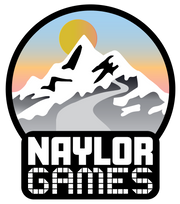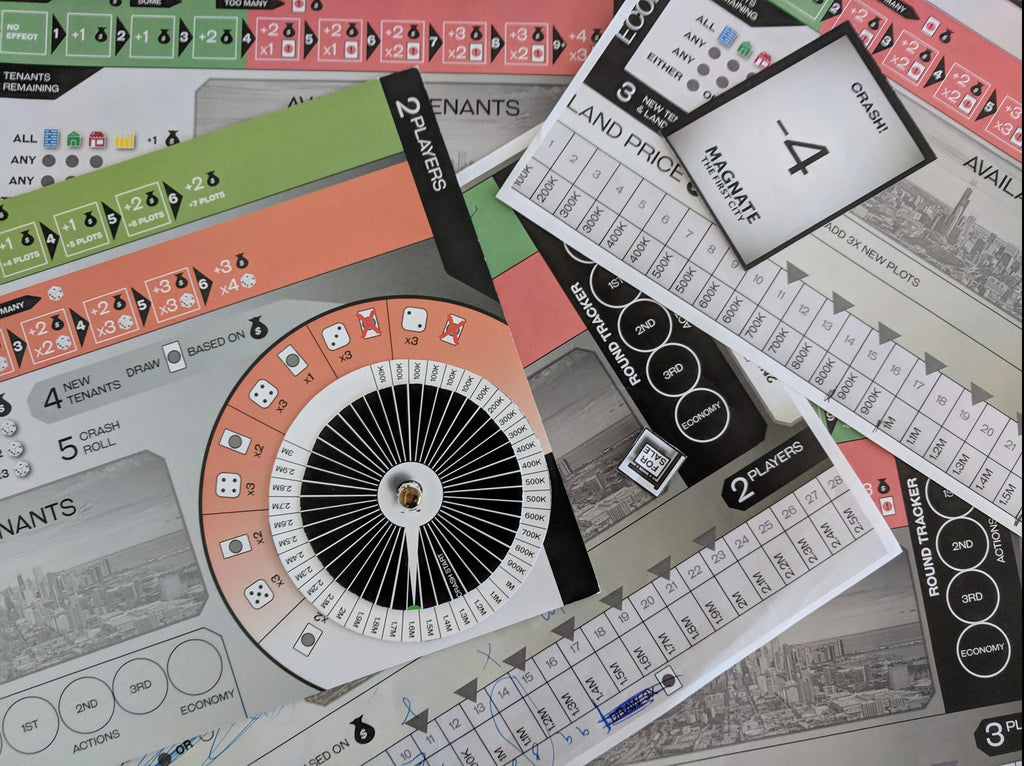Has it really been two months already? Unsurprisingly, there’s lots to catch-up on with progress on playtesting, design and ever increasing public awareness of the game!
Building the coverage
Over the last few months the amount of coverage Magnate has received in the press has started to swell. Some swift googling revealed a mini post Essen flurry of articles like this, this and this. We even got a mention on the Polyhedron Collider’s most anticipated games of 2019 podcast! Rory Somers, one of the “colliders”(?) had already given us a great little write-up in his review of Dragonmeet, but it was awesome to see Magnate specifically called out as anticipated alongside much more famous names like Wingspan and Munchkin.
At the same time, the mailing list has grown and – perhaps, most surprising for me – as has the interest on BGG. Magnate currently figures in a whole bunch of lists and there have been quite a few conversations about it around the site. This being my first KS, I don’t know whether the level of chatter is relatively strong or weak for a first time creator at this stage in our campaign, but I’m not sure I care too much: I’m still bowled over that *my* game is something a lot of people are keen to play!
Production values
I’ve always known that level of “production value” I want for Magnate is at least as good as you would expect from a big publisher – like an Asmodee company or CMON. For a first timer like me who still has a huge amount to learn about art direction and manufacturing, that is not an easy bar to meet. It’s doubly hard when your game is relatively component heavy like Magnate – especially when it incorporates realistic miniatures!
As a result of sticking to this standard, it’s taking us longer than originally forecasted to get the game’s physical components finalised. It’s taken a while to find a new 3D designer who can do justice to bring the enchanting character we need them to have to really delight players. And the graphic design and branding elements still have some way to go to reach the level of coherence and usability needed to crush our design goals.
What that now means is we’re probably going to launch our Kickstarter later than planned; resulting a 2-3 month delay overall. That’s a bit disappointing for me, because I want to share this game with the world as soon a I can – but if it’s not there, it’s not there yet! I am reminded of Jamey Stegmaier’s words: You don’t have to launch today. If I know that 2-3 months out, that’s even better. That being said, I hope to have some fresh visuals to show soon.
Is perfectionism a risk here? Always. But I don’t think it’s smart to do anything but push the game until it’s so good that the law of diminishing returns really does make it fruitless to go further. I am convinced it only good business sense to keep standards high: In the ever more saturated market we’re in, the game needs to be an all-round excellent product to compete. Ultimately, I don’t subscribe to the theory that one should keep grinding out games to play the numbers. Instead, I suspect the Blockbuster approach has the upper-hand, just like it does at the cinema; it just takes longer to become apparent because of how games are sold, distributed and learned by players.
While I very much hope I am right on that, the great thing is this: even if the game was a a very moderate success, it doesn’t really matter. This is a true passion project. If this was the only game I ever self-published I’d want it to be the best it can reasonably be, regardless of sales.
Eat, sleep, playtest, repeat*
*With apologies to Gabe Barrrett
One thing production delays only enhance is the opportunity to do even more playtesting than we already had planned. I am also fully subscribed to the idea you can never do enough playtesting: it’s just a question of when you decide to say ‘down tools’ because the game is doing a) what it was envisioned to do and b) you’re comfortable that if there are any undetected ‘bugs’ left, they are so tiny and infrequent that they aren’t a real problem. Tough calls both.
As I mentioned in the last update, I took on a new team member – Jaya – to accelerate this process back in November. It was becoming critical to do because, as we closed on the final 85% of the design, the law of diminishing returns was going to make traversing that final 15% painfully slow.
I am glad to report this has worked very well indeed. It us allowed me to test numerous scenarios to smash bugs and refine the experience: constantly shaving off unproductive complexity here and there. So many small things (right down to a subtle change in how marketing works or balancing the action efficiency of particular player tactics) have improved.
Having another close game design collaborator with a razor like focus on player experience at all points, has also raised my bar and given me the headspace to see the game more objectively. While my approach is always to keep asking the question “what, specifically, does need to be?”, Jaya’s involvement has made me accept things which I kind of knew but wasn’t admitting to myself. A big one is that the economy board. While essential, is still too admin heavy and intimidating looking for the target market: a) the “gateway” to “trans-gateway” market of people who have already discovered the likes of Catan, Carcassone and Ticket to Ride and are looking for more of the same or a small step-up (i.e. not Lisboa or Gaia Project!) and b) Families with older children that are already into more complex games and want to build actual 3D things!
We’ve already simplified the way the economy works quite a bit; all while retaining the same level of player nuance, interaction and the ability to forecast future game state which previous versions enabled. I am hopeful that our next round of changes will make it even more approachable.
Handycon
Just this weekend I was, once again, back at the twice-yearly gaming convention in Madienhead to test some of those latest game changes. Once again, it was a huge success; including a 4 player game that hummed along beautifully! Feedback was pretty much all entirely about graphic design; and all stuff I already knew.
I also took things a little easier this time and got in quite a few games other than Magnate (Shocking!). This included the excellent Architects of the West Kingdom, which was the standout new game to me of this event. You may well have heard about it already – I am seriously late to the party in BG media terms, after all. But I am happy to confirm it really is a very well produced product with an effective combination of very familiar elements (worker placement, medieval theme, tracks you can traverse up and down with various effects at either end) with a newer idea that I could see becoming a future staple: placing many workers on the same spot to generate exponential returns that simultaneously increase the probability that they will be captured by an opponent. A nice fusion of the seasoned gamers most sought-after prize (action efficiency!) with push your luck and, dare I say, a bit of diplomacy.
As always, Handycon is a very friendly show where I am now finding I know a ton of people already when I arrive. Whenever I wanted to play, I was never short of an opportunity to try something new or find willing victims for playtesting purposes. Their choice to stick with the Holiday Inn as their venue has been a welcome one too; it’s a good hotel (with great early room rate discounts) and the food is above the convention average. Definitely recommended to anyone looking for a primarily open-gaming driven experience; especially if you’re based in the Southeast.


Leave a comment